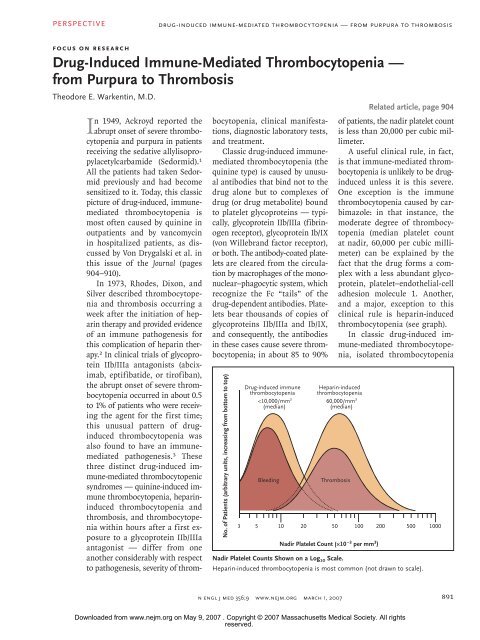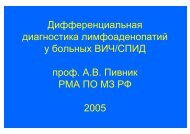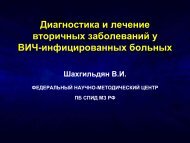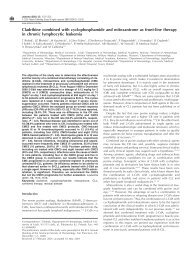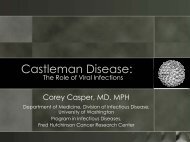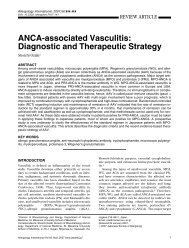Drug-Induced Immune-Mediated Thrombocytopenia ... - Hem-aids.ru
Drug-Induced Immune-Mediated Thrombocytopenia ... - Hem-aids.ru
Drug-Induced Immune-Mediated Thrombocytopenia ... - Hem-aids.ru
Create successful ePaper yourself
Turn your PDF publications into a flip-book with our unique Google optimized e-Paper software.
PERSPECTIVE<br />
<strong>D<strong>ru</strong>g</strong>-<strong>Induced</strong> <strong>Immune</strong>-<strong>Mediated</strong> <strong>Thrombocytopenia</strong> — From Purpura to Thrombosis<br />
FOCUS ON RESEARCH<br />
<strong>D<strong>ru</strong>g</strong>-<strong>Induced</strong> <strong>Immune</strong>-<strong>Mediated</strong> <strong>Thrombocytopenia</strong> —<br />
from Purpura to Thrombosis<br />
Theodore E. Warkentin, M.D.<br />
In 1949, Ackroyd reported the<br />
ab<strong>ru</strong>pt onset of severe thrombocytopenia<br />
and purpura in patients<br />
receiving the sedative allylisopropylacetylcarbamide<br />
(Sedormid). 1<br />
All the patients had taken Sedormid<br />
previously and had become<br />
sensitized to it. Today, this classic<br />
picture of d<strong>ru</strong>g-induced, immunemediated<br />
thrombocytopenia is<br />
most often caused by quinine in<br />
outpatients and by vancomycin<br />
in hospitalized patients, as discussed<br />
by Von Drygalski et al. in<br />
this issue of the Journal (pages<br />
904–910).<br />
In 1973, Rhodes, Dixon, and<br />
Silver described thrombocytopenia<br />
and thrombosis occurring a<br />
week after the initiation of heparin<br />
therapy and provided evidence<br />
of an immune pathogenesis for<br />
this complication of heparin therapy.<br />
2 In clinical trials of glycoprotein<br />
IIb/IIIa antagonists (abciximab,<br />
eptifibatide, or tirofiban),<br />
the ab<strong>ru</strong>pt onset of severe thrombocytopenia<br />
occurred in about 0.5<br />
to 1% of patients who were receiving<br />
the agent for the first time;<br />
this unusual pattern of d<strong>ru</strong>ginduced<br />
thrombocytopenia was<br />
also found to have an immunemediated<br />
pathogenesis. 3 These<br />
three distinct d<strong>ru</strong>g-induced immune-mediated<br />
thrombocytopenic<br />
syndromes — quinine-induced immune<br />
thrombocytopenia, heparininduced<br />
thrombocytopenia and<br />
thrombosis, and thrombocytopenia<br />
within hours after a first exposure<br />
to a glycoprotein IIb/IIIa<br />
antagonist — differ from one<br />
another considerably with respect<br />
to pathogenesis, severity of thrombocytopenia,<br />
clinical manifestations,<br />
diagnostic laboratory tests,<br />
and treatment.<br />
Classic d<strong>ru</strong>g-induced immunemediated<br />
thrombocytopenia (the<br />
quinine type) is caused by unusual<br />
antibodies that bind not to the<br />
d<strong>ru</strong>g alone but to complexes of<br />
d<strong>ru</strong>g (or d<strong>ru</strong>g metabolite) bound<br />
to platelet glycoproteins — typically,<br />
glycoprotein IIb/IIIa (fibrinogen<br />
receptor), glycoprotein Ib/IX<br />
(von Willebrand factor receptor),<br />
or both. The antibody-coated platelets<br />
are cleared from the circulation<br />
by macrophages of the mononuclear–phagocytic<br />
system, which<br />
recognize the Fc “tails” of the<br />
d<strong>ru</strong>g-dependent antibodies. Platelets<br />
bear thousands of copies of<br />
glycoproteins IIb/IIIa and Ib/IX,<br />
and consequently, the antibodies<br />
in these cases cause severe thrombocytopenia;<br />
in about 85 to 90%<br />
No. of Patients (arbitrary units, increasing from bottom to top)<br />
<strong>D<strong>ru</strong>g</strong>-induced immune<br />
thrombocytopenia<br />
PERSPECTIVE<br />
<strong>D<strong>ru</strong>g</strong>-<strong>Induced</strong> <strong>Immune</strong>-<strong>Mediated</strong> <strong>Thrombocytopenia</strong> — From Purpura to Thrombosis<br />
Heparin-induced thrombocytopenia antibodies also<br />
activate endothelial cells and monocytes (not shown)<br />
<strong>D<strong>ru</strong>g</strong><br />
Platelet clearance<br />
by phagocytic cells<br />
<strong>D<strong>ru</strong>g</strong><br />
Heparin<br />
PF4<br />
IIb<br />
IIIa<br />
Neoepitope<br />
FcγRIIa<br />
Procoagulant<br />
platelet-derived<br />
microparticles<br />
Platelet membrane<br />
Platelet<br />
activation<br />
Classic <strong>D<strong>ru</strong>g</strong>-<strong>Induced</strong><br />
<strong>Immune</strong> <strong>Thrombocytopenia</strong><br />
Antibody binds to d<strong>ru</strong>g or<br />
d<strong>ru</strong>g metabolite–GP complex<br />
<strong>Immune</strong> <strong>Thrombocytopenia</strong><br />
Associated with GPIIb/IIIa Antagonists<br />
<strong>D<strong>ru</strong>g</strong> (eptifibatide, tirofiban, abciximab)<br />
binds to GPIIb/IIIa, exposing a neoepitope<br />
elsewhere on GPIIb/IIIa complex<br />
Heparin-<strong>Induced</strong><br />
<strong>Thrombocytopenia</strong><br />
IgG recognizes PF4 bound to<br />
heparin; clustering of FcγIIa receptors<br />
leads to platelet activation<br />
<strong>Immune</strong>-<strong>Mediated</strong> <strong>Thrombocytopenia</strong>.<br />
COLOR FIGURE<br />
Naturally occurring antibodies can explain the rapid onset of thrombocytopenia with glycoprotein (GP) IIb/IIIa antagonists, even in<br />
the absence of previous d<strong>ru</strong>g exposure. In the case of abciximab-induced thrombocytopenia, naturally occurring Draft 7 antibodies 2/06/07 against<br />
Author Warketin<br />
the mouse anti–GPIIb/IIIa domain are reported. FcγRIIa denotes Fcγ receptor IIa, and PF4 platelet factor 4.<br />
Fig # 2<br />
Title<br />
and purpura (especially petechiae)<br />
are prominent. Especially with<br />
quinine, a minority of patients<br />
evince concomitant immune neutropenia,<br />
disseminated intravascular<br />
coagulation, or the hemolytic–uremic<br />
syndrome. Only about<br />
three dozen d<strong>ru</strong>gs have been convincingly<br />
implicated as causes of<br />
immune-mediated thrombocytopenia.<br />
4,5 These d<strong>ru</strong>g reactions are<br />
rare, occurring in only a few exposed<br />
patients among many thousands.<br />
When the implicated d<strong>ru</strong>g<br />
(such as vancomycin) is given infrequently<br />
to a particular patient,<br />
onset of thrombocytopenia typically<br />
occurs about a week after<br />
therapy begins. When a person is<br />
exposed to a d<strong>ru</strong>g intermittently<br />
(as with quinine contained in<br />
tonic water or used to treat leg<br />
cramps), the onset is usually<br />
ab<strong>ru</strong>pt, reflecting re-exposure in<br />
a sensitized patient. Along with<br />
the rapid drop in the platelet count,<br />
there may be an anaphylactoid<br />
reaction. This type of rapidly developing<br />
thrombocytopenia can<br />
occur in a patient who had previously<br />
received the d<strong>ru</strong>g many<br />
weeks or even years earlier. Treatment<br />
includes cessation of use of<br />
the d<strong>ru</strong>g and either simple support<br />
or measures to increase the<br />
platelet count (e.g., intravenous<br />
immune globulin), depending on<br />
the severity of the bleeding. Fatal<br />
hemorrhage, usually from intracranial<br />
bleeding, is rare.<br />
<strong>Immune</strong>-mediated thrombocytopenia<br />
associated with glycoprotein<br />
IIb/IIIa antagonists resembles<br />
the classic syndrome with respect<br />
to the severity of thrombocytopenia,<br />
the risk of bleeding, and occasional<br />
anaphylactoid reactions.<br />
In these cases, however, the thrombocytopenia<br />
is usually evident<br />
within hours after d<strong>ru</strong>g adminis-<br />
<strong>D<strong>ru</strong>g</strong>-<strong>Induced</strong> <strong>Immune</strong> <strong>Thrombocytopenia</strong><br />
tration begins, ME even CH though most<br />
patients do DE Schwartz<br />
not have a history of<br />
Artist KMK<br />
previous exposure AUTHOR to PLEASE the NOTE: glycoprotein<br />
IIb/IIIa antagonist. In the<br />
Please check carefully<br />
Figure has been redrawn and type has been reset<br />
Issue date<br />
cases of eptifibatide 3/1/07 and tirofiban,<br />
an explanation of this paradox<br />
is that naturally occurring antibodies<br />
against glycoprotein IIb/<br />
IIIa can bind to st<strong>ru</strong>ctures in<br />
the glycoprotein that are revealed<br />
by d<strong>ru</strong>g-induced conformational<br />
changes (a neoepitope) in the glycoprotein<br />
complex (see diagram).<br />
In the case of abciximab, which<br />
is a chimeric (human–mouse) Fab<br />
fragment, naturally occurring antibodies<br />
against the mouse anti–<br />
glycoprotein IIb/IIIa domain could<br />
explain an ab<strong>ru</strong>pt onset of thrombocytopenia.<br />
With all three glycoprotein<br />
IIb/IIIa antagonists, antibodies induced<br />
by the first administration<br />
can lead to rapid-onset thrombocytopenia<br />
on re-exposure to the<br />
892<br />
n engl j med 356;9 www.nejm.org march 1, 2007<br />
Downloaded from www.nejm.org on May 9, 2007 . Copyright © 2007 Massachusetts Medical Society. All rights<br />
reserved.
PERSPECTIVE<br />
<strong>D<strong>ru</strong>g</strong>-<strong>Induced</strong> <strong>Immune</strong>-<strong>Mediated</strong> <strong>Thrombocytopenia</strong> — From Purpura to Thrombosis<br />
d<strong>ru</strong>g. With abciximab, which binds<br />
irreversibly to platelets, thrombocytopenia<br />
can occur even a week<br />
after an initial brief exposure to<br />
the d<strong>ru</strong>g. Platelet transfusions can<br />
raise the platelet count in cases<br />
of thrombocytopenia caused by<br />
abciximab but are usually less<br />
helpful with thrombocytopenia<br />
caused by eptifibatide or tirofiban.<br />
In some patients who seem to have<br />
thrombocytopenia after the administration<br />
of a glycoprotein IIb/<br />
IIIa antagonist, there is platelet<br />
clumping in vitro, caused by naturally<br />
occurring EDTA-dependent<br />
antibodies; in such cases, no<br />
treatment is indicated, since the<br />
thrombocytopenia is spurious.<br />
Heparin-induced thrombocytopenia<br />
is a distinctive antibodymediated<br />
syndrome. The degree<br />
of thrombocytopenia is usually<br />
moderate (median platelet count<br />
at nadir, 60,000 per cubic millimeter);<br />
in 85 to 90% of patients,<br />
the platelet count is above 20,000<br />
per cubic millimeter. The thrombocytopenia<br />
is caused by heparindependent<br />
IgG antibodies that<br />
bind to multimolecular complexes<br />
consisting of platelet factor 4 (PF4)<br />
bound to heparin. The antibodies<br />
activate platelets by means of<br />
their FcγIIa receptors, releasing<br />
platelet-derived procoagulant microparticles.<br />
These microparticles<br />
accelerate coagulation reactions<br />
and the generation of thrombin.<br />
Venous thromboembolism (the<br />
most common complication), arterial<br />
thrombosis (especially involving<br />
limb and cerebral arteries),<br />
adrenal hemorrhagic necrosis<br />
(due to adrenal-vein thrombosis),<br />
necrotizing skin lesions at heparin-injection<br />
sites, anaphylactoid<br />
reactions after an intravenous bolus<br />
of heparin, and overt disseminated<br />
intravascular coagulation<br />
can occur.<br />
Stopping heparin therapy does<br />
not prevent further thrombosis,<br />
necessitating inhibition of thrombin<br />
or its generation by rapidly<br />
acting non-heparin anticoagulants.<br />
Anticoagulation with coumarin<br />
(warfarin) substantially increases<br />
the risk of microvascular thrombosis<br />
(causing venous limb gangrene<br />
and skin necrosis), and it<br />
is therefore contraindicated during<br />
the acute thrombocytopenic<br />
phase.<br />
The pathogenic antibodies appear<br />
in the blood only transiently,<br />
which means that a rapid onset of<br />
thrombocytopenia on beginning<br />
heparin therapy occurs only in patients<br />
who have been exposed to<br />
heparin within the previous several<br />
weeks. Indeed, deliberate brief<br />
re-exposure to heparin, such as<br />
for cardiac surgery, is feasible after<br />
recovery from an episode of<br />
heparin-induced thrombocytopenia.<br />
Sometimes, thrombocytopenia<br />
and thrombosis begin a week<br />
or two after all heparin therapy<br />
has been stopped (“delayed-onset”<br />
heparin-induced thrombocytopenia).<br />
Unlike the purpura-inducing<br />
d<strong>ru</strong>g reactions discussed above,<br />
which only rarely have long-term<br />
effects, heparin-induced thrombocytopenia<br />
is often associated with<br />
long-term sequelae from thrombosis.<br />
Laboratory detection of d<strong>ru</strong>gdependent<br />
antibodies can be invaluable.<br />
For the classic syndrome,<br />
detection of d<strong>ru</strong>g-dependent (or<br />
d<strong>ru</strong>g-metabolite–dependent) binding<br />
of antibodies to platelet glycoproteins<br />
has high specificity but<br />
only moderate sensitivity, perhaps<br />
because relevant d<strong>ru</strong>g metabolites<br />
may not be present within the test<br />
system. In contrast, with thrombocytopenia<br />
associated with glycoprotein<br />
IIb/IIIa antagonists or<br />
heparin, the challenge is to distinguish<br />
nonpathogenic from<br />
pathogenic antibodies. Thus, for<br />
heparin-induced thrombocytopenia,<br />
test sensitivity is high, but<br />
specificity (especially with the use<br />
of enzyme immunoassays for antibodies<br />
against the PF4–heparin<br />
complexes) is only moderate. This<br />
is because heparin frequently induces<br />
formation of heparin-dependent<br />
antibodies, but only some of<br />
these have the biologic properties<br />
needed to activate platelets and<br />
thereby evince their pathogenic<br />
potential. Although commercial<br />
enzyme immunoassays permit<br />
many hospitals to offer standardized<br />
testing for antibodies against<br />
the PF4–heparin complexes, all the<br />
other tests for d<strong>ru</strong>g-dependent<br />
antibodies require referral to a<br />
handful of specialized reference<br />
laboratories.<br />
Dr. Warkentin reports receiving consulting<br />
or lecture fees from GlaxoSmithKline,<br />
Organon, GTI, the Medicines Company,<br />
Oryx Pharmaceuticals, and Sanofi-Aventis,<br />
as well as grant support from Sanofi-Aventis,<br />
Organon, and GlaxoSmithKline. No other<br />
potential conflict of interest relevant to this<br />
article was reported.<br />
Dr. Warkentin is a professor of pathology<br />
and molecular medicine and medicine at<br />
the Faculty of Health Sciences, McMaster<br />
University, Hamilton, ON, Canada.<br />
1. Ackroyd JF. The pathogenesis of thrombocytopenic<br />
purpura due to hypersensitivity to<br />
Sedormid (allyl-isopropyl-acetyl-carbamide).<br />
Clin Sci 1949;7:249-85.<br />
2. Rhodes GR, Dixon RH, Silver D. Heparin<br />
induced thrombocytopenia with thrombotic<br />
and hemorrhagic manifestations. Surg Gynecol<br />
Obstet 1973;136:409-16.<br />
3. Aster RH, Curtis BR, Bougie DW, et al.<br />
<strong>Thrombocytopenia</strong> associated with the use<br />
of GPIIb/IIIa inhibitors: position paper of the<br />
ISTH working group on thrombocytopenia<br />
and GPIIb/IIIa inhibitors. J Thromb Haemost<br />
2006;4:678-9.<br />
4. Warkentin TE, Kelton JG. <strong>Thrombocytopenia</strong><br />
due to platelet dest<strong>ru</strong>ction and hypersplenism.<br />
In: Hoffman R, Benz EJ Jr, Shattil<br />
SJ, et al., eds. <strong>Hem</strong>atology: basic principles<br />
and practice. 4th ed. New York: Elsevier<br />
Churchill Livingstone, 2005:2305-25.<br />
5. Tinmouth AT, Semple E, Shehata N,<br />
Branch DR. Platelet immunopathology and<br />
therapy: a Canadian Blood Services Research<br />
and Development symposium. Transfus Med<br />
Rev 2006;20:294-314.<br />
Copyright © 2007 Massachusetts Medical Society.<br />
n engl j med 356;9 www.nejm.org march 1, 2007<br />
893<br />
Downloaded from www.nejm.org on May 9, 2007 . Copyright © 2007 Massachusetts Medical Society. All rights<br />
reserved.


